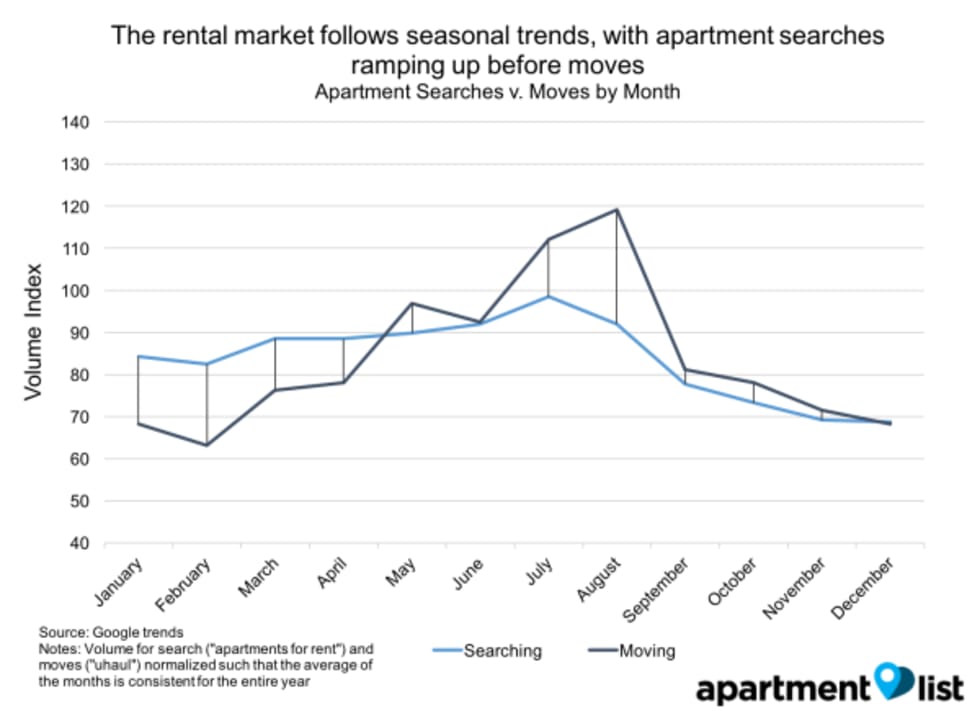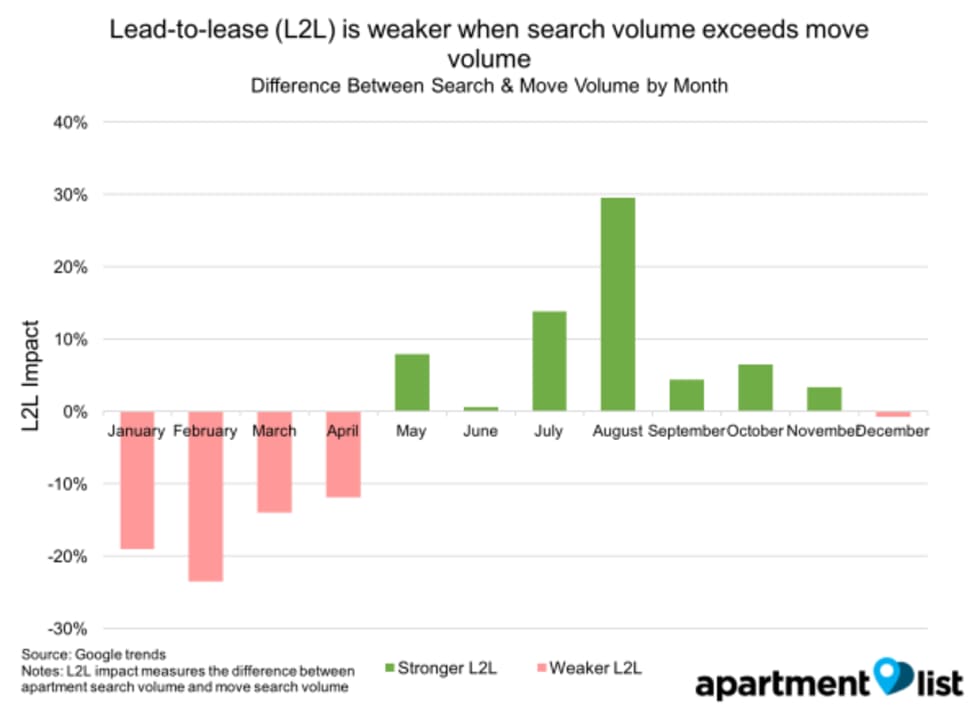How Does Seasonality Impact the Rental Market?

Apartment searches and moves follow a seasonal trend, known as seasonality. Searches tick up in January and grow steadily to their July peak; while moves start ramping up in March and peak in August.
Renters that start their search at the beginning of the year take longer to move, but still move in at almost the same rate as peak month searchers
Seasonality and mismatch in search versus move timing can significantly impact how lead quality is measured if not done on a cohort basis. When measuring lead quality (lead-to-lease) on a monthly basis, properties will see a decrease in lead conversion in certain periods of the year due to seasonality in moves.
Renting, like sports and produce, follows predictable seasonal patterns each year, commonly referred to as “seasonality.” Seasonality has significant influences on the rental market, influencing the daily decisions of property managers, leasing agents and renters. Our Apartment List team of business experts and researchers has put together must-know data on seasonality. Let’s examine how big the swings in seasonality are - for both searching and moving - and how that impacts your in month lead-to-lease rate.
Moving Season Starts Way After Searching Season

Although renters move year-round, certain times of year are more popular than others, with moves peaking in August. Interestingly, but not surprisingly, apartment searching and moving follow slightly different trends. Searches for apartments jump from December to January and then ramp up gradually through the spring and summer months. Apartment searches peak in July, before tapering off in the final three months of the year. Moves, on the other hand, are relatively quiet at the start of the year, before ramping up dramatically from March to their August peak.
How Big An Impact Does Seasonality Have on Moving?
As seen above many more renters start their search in the beginning of the year than actually move then. And these renters are actually different both in how many of them eventually move and how long it takes them to move.
Early Season Renters Really ARE planners
First, renters who start their search and contact properties at the beginning of the year seem to be “planners” who on average take longer to move than renters who start their search in the summer. In fact, of renters who start their search in July, 25 percent more of them will move in the next 30 days as compared to renters who start in January. The converse is also true, 22 percent more of January renters will take more than 90 days to move compared to their July counterparts.

But some of those renters are just window shoppers
So even though we do see that those January renters take longer to move and eventually do move, early season renters tend to be more window shoppers who aren’t actually going to take the plunge that year. Renters that begin their search in the first quarter of the year are 10 percent less likely to actually move than those searching in the peak summer months. Renters who begin their search in Q2 are your best bets to move in.

So What Does This All Mean?
At Apartment List, we know properties look at the conversion rate of leads to leases (L2L) as a measure of lead quality. But given what we highlighted above, how you measure your L2L rate is significantly impacted by HOW and WHEN in the year you do it.
The simplest and quickest way to do this is to look at all leases in a time period overall leads in a time period. If your time period covers an entire year or multiples of years, you are not going to season any distortion from the seasonality we highlighted above.
However, if you are looking at leases in one month over leads in month the time of year it will significantly impact your lead-to-lease rate. Lead-to-lease rates will tend to look great in the summer and much worse to start the year.
To control for the impacts of seasonality and the mismatch between search volume and when renters move, the best way to look at this is on a cohort basis. To do this take all of your leads in a given month and then all of the leases that are attributed to those leads. The results will update each month as more leases roll in and you won’t have to worry about seasonality, growth or mix skewing your results.
It really does matter!
As we’ve established, searches and moves follow slightly different seasons. When searches increase before moves, properties will see an increase in lead volume relative to leases. For example, properties see a significant increase in lead volume from January but a modest increase in leases as those leads will take some time to mature into a lease. This means that in-month lead-to-lease will look worse in January due to seasonal trends without any changes to the actual lead quality (or likelihood of that those leads ultimately turn into a lease).

As shown in the graph above, when search volume outpaces moving volume (the pink bars), in-month L2L will understate true performance and properties will experience relatively fewer move-ins than leads. This is the case in winter and early spring. When moving outpaces search (shown in green), in-month L2L will overstate true performance, and properties will experience relatively more move-ins than leads. This is the case in May through October. This disparity occurs because there is a lag between when a lead is sent and when a renter ultimately moves in. Leads can often take three or more months before they ultimately mature into a lease. Further, the shapes of these curves demonstrate that users who search in the beginning of the year tend to be starting their search earlier than someone who is beginning in July or August and operating on a more compressed timeframe.
Conclusion
Apartment searches tick up from December to January and grow steadily to their July peak. Moves, on the other hand, begin ticking up in March and increase dramatically to their peak in August. As moves begin slowing down in the fall, rent prices tend to fall, as demand softens.
Seasonality in the rental market impacts both sides of the rental market influencing decisions made by both renters and property managers. For property managers, seasonality has significant impacts on lead-to-lease, a common measure of lead quality. When search volume outpaces moving volume, in-month L2L will understate true performance, and when moving outpaces search, in-month L2L will overstate actual true performance. For renters, moving in the “off-season” (December or January) can offer deals, while moving in peak-season (July or August) offers the best selection of rentals. Both property managers and renters can optimize for seasonality by factoring the volume of apartment searching and moving into their decisions.
Share this Article
